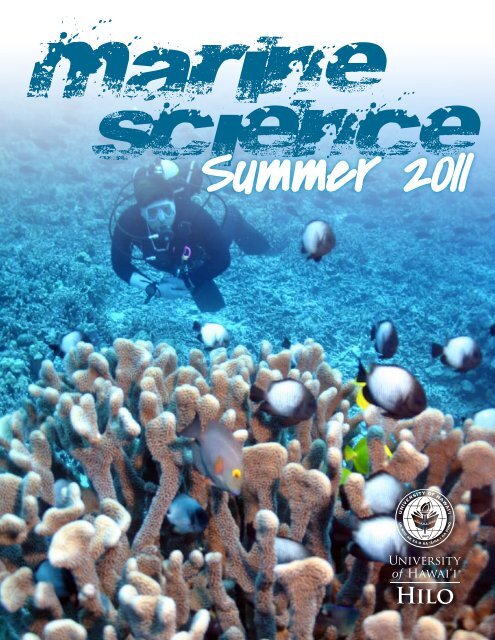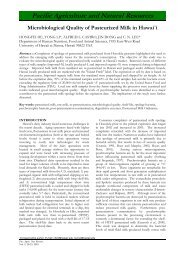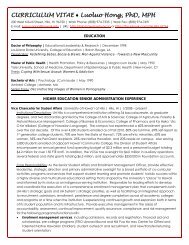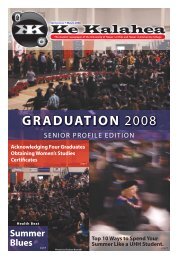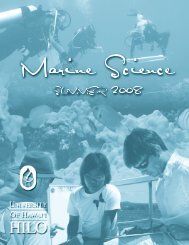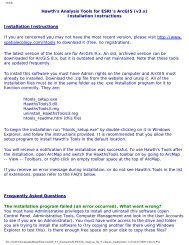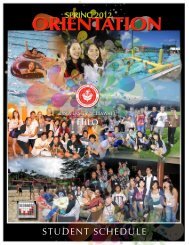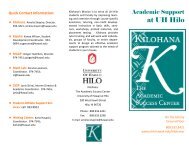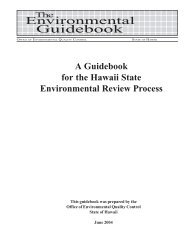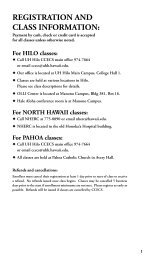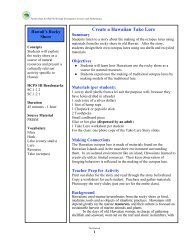Summer 2011 - University of Hawaii at Hilo
Summer 2011 - University of Hawaii at Hilo
Summer 2011 - University of Hawaii at Hilo
Create successful ePaper yourself
Turn your PDF publications into a flip-book with our unique Google optimized e-Paper software.
<strong>Summer</strong> <strong>2011</strong>
<strong>University</strong> <strong>of</strong> Hawai‘i <strong>at</strong> <strong>Hilo</strong> <strong>Summer</strong> Session in Marine Science 3<br />
Marine Science<br />
On the Big Island <strong>of</strong> Hawai‘i<br />
The Marine Science program <strong>at</strong> the <strong>University</strong> <strong>of</strong><br />
Hawai‘i <strong>at</strong> <strong>Hilo</strong> is designed to take full advantage <strong>of</strong><br />
the “Big Island” <strong>of</strong> Hawai‘i’s variety <strong>of</strong> marine environments<br />
ranging from deep ocean to coral reef to estuary.<br />
An exciting array <strong>of</strong> ocean activities is planned. These<br />
activities are designed to stimul<strong>at</strong>e the student’s interest,<br />
provide experience-oriented learning and take full<br />
advantage <strong>of</strong> the island’s exotic <strong>of</strong>ferings.<br />
The Island <strong>of</strong> Hawai‘i is a treasure <strong>of</strong> unique diversity.<br />
With its sometimes snow-capped mountain peaks,<br />
pasture lands, lush tropical rain forests, rainbow-arched<br />
valleys, and active volcanoes, the Big Island has been<br />
described as a tropical mini-continent. An intern<strong>at</strong>ionally<br />
renowned site for astronomical observ<strong>at</strong>ion the island<br />
is also home <strong>of</strong> the world-famous <strong>Hawaii</strong>an Volcanoes<br />
Observ<strong>at</strong>ory. The island boasts beaches <strong>of</strong> black, white<br />
or green sand providing uncrowded access to pristine<br />
w<strong>at</strong>ers. Scientists and visitors alike are afforded the possibility<br />
<strong>of</strong> observing glowing red lava flowing into the<br />
sea from coastal vents. The Big Island is twice the size <strong>of</strong><br />
all the other <strong>Hawaii</strong>an Islands put together and unsurpassed<br />
in beauty by any other island in the <strong>Hawaii</strong>an<br />
chain. From its people who carry with them the “Aloha”<br />
to the richness <strong>of</strong> its lands, the Big Island <strong>of</strong> Hawai‘i is<br />
the perfect place to spend the summer learning about<br />
the wonders <strong>of</strong> the sea.<br />
The <strong>University</strong> <strong>of</strong> Hawai‘i <strong>at</strong> <strong>Hilo</strong>, fully accredited by<br />
the Western Associ<strong>at</strong>ion <strong>of</strong> Schools and Colleges, is<br />
a part <strong>of</strong> the Hawai‘i system <strong>of</strong> higher educ<strong>at</strong>ion. Its<br />
programs emphasize accessibility to facilities and instructors<br />
in a small campus <strong>at</strong>mosphere. Teaching is a<br />
priority concern <strong>of</strong> all UH <strong>Hilo</strong> Faculty. Pr<strong>of</strong>essors are<br />
encouraged to involve students in their own research<br />
and public<strong>at</strong>ions; as a result, UH <strong>Hilo</strong> students do very<br />
well in gradu<strong>at</strong>e school. UH <strong>Hilo</strong> Marine Science<br />
Faculty also taps into the rich cultural heritage<br />
and environmental resources <strong>of</strong> the Big Island<br />
in such programs as the Marine Science<br />
Department, the Marine Science <strong>Summer</strong><br />
Program, the Kalakaua Marine Educ<strong>at</strong>ion<br />
Center, and the Marine Option<br />
Program.<br />
Combining an ideal environment, excellent curriculum,<br />
outstanding instructors, and its own new labor<strong>at</strong>ory and<br />
classroom building, and research/teaching vessel, the<br />
UH <strong>Hilo</strong> Marine Science <strong>Summer</strong> Program is one <strong>of</strong> the<br />
best opportunities in the n<strong>at</strong>ion for undergradu<strong>at</strong>es to<br />
study marine science. In recognition <strong>of</strong> this exceptional<br />
summer program the UH <strong>Hilo</strong> Marine Science <strong>Summer</strong><br />
Program has received an “Award for Excellence <strong>of</strong> Program”<br />
from the Western Associ<strong>at</strong>ion <strong>of</strong> <strong>Summer</strong> School<br />
Administr<strong>at</strong>ors, an organiz<strong>at</strong>ion representing over 80<br />
member universities in the western U.S., Canada, and<br />
Mexico.<br />
For inform<strong>at</strong>ion about the <strong>2011</strong> <strong>Summer</strong> Session in Marine<br />
Science <strong>at</strong> UH <strong>Hilo</strong> contact:<br />
UH <strong>Hilo</strong> CCECS <strong>at</strong>:<br />
Phone: (808) 974-7664<br />
Fax: (808) 933-8863<br />
e-mail: ccecs@hawaii.edu<br />
Web site: http://hilo.hawaii.edu/depts/summer<br />
or<br />
http://www.kmec.uhh.hawaii.edu<br />
Write to:<br />
<strong>Summer</strong> Program in Marine Science<br />
<strong>University</strong> <strong>of</strong> Hawai‘i <strong>at</strong> <strong>Hilo</strong> - CCECS<br />
200 West Kawili Street<br />
<strong>Hilo</strong>, Hawai‘i 96720-4091
4 <strong>University</strong> <strong>of</strong> Hawai‘i <strong>at</strong> <strong>Hilo</strong> <strong>Summer</strong> Session in Marine Science<br />
<strong>Summer</strong> <strong>2011</strong> Marine Science Course Offerings<br />
Courses with Special Schedules, May 16-28, <strong>2011</strong><br />
CRN Credits Course Sec Title Instructor Days Times Loc<strong>at</strong>ion<br />
12131 3 MARE 264 001 Beg QUEST Team UMTWRFS 8 am-10 pm Kona<br />
12132 3 MARE 364 001 Adv QUEST Team UMTWRFS 8 am-10 pm Kona<br />
(MARE 364 starts on May 15)<br />
<strong>Summer</strong> Session II, June 13-July 22, <strong>2011</strong><br />
12096 2 MARE 101L 001 Marine Science Field Lab J Turner & W 8 am-12 pm MSB 104<br />
J Adolf<br />
12097 3 MARE 140 001 Intro to Hawn Coral Reefs JS Turner MTRF 10-11:50 am MSB 104<br />
12098 1 MARE 140L 001 Hawn Coral Reefs Lab S Turner M 1-5 pm MSB 104<br />
12099 3 MARE/BIOL 171 001 Marine Biology JS Turner MTRF 8-9:50 am MSB 104<br />
12157 3 MARE 294 001 Polynesian Sail & Navig<strong>at</strong>ion I Pilago MTRF 1-2:50 pm MSB 101<br />
12158 1 MARE 294L 001 Polynesian Sail & Navig<strong>at</strong>ion Lab I Pilago W 1-5 pm MSB 101<br />
12133 3 MARE 366 001 Trop Marine Resarch Investig<strong>at</strong>ions S Colbert MTRF 8-9:50 am MSB 101<br />
12159 3 MARE 394 001 N<strong>at</strong>ural Hist <strong>of</strong> Sharks/Rays J Turner MTRF 8-9:50 am MSB 103<br />
12165 1 MARE 394L 001 N<strong>at</strong> Hist <strong>of</strong> Sharks/Rays Lab J Turner F 6-10 pm MSB 104<br />
12101 3 MARE 490 001 Marine Reptile Conserv<strong>at</strong>ion & Ecology J Turner MTRF 10-11:50 am MSB 103<br />
12102 1 MARE 490L 001 Marine Reptile Cons & Ecol Lab J Turner W 1-5 pm MSB 104<br />
12153 3 MARE 494 001 Phytoplankton Ecology J Adolf MTRF 10-11:50 am MSB 101<br />
12154 1 MARE 494L 001 Phytoplankton Ecol Lab J Adolf F 1-5 pm MSB 104
<strong>University</strong> <strong>of</strong> Hawai‘i <strong>at</strong> <strong>Hilo</strong> <strong>Summer</strong> Session in Marine Science 5<br />
<strong>Summer</strong> <strong>2011</strong><br />
Marine Science Course Descriptions<br />
MARE 101L, Introduction to Marine Science Field<br />
Labor<strong>at</strong>ory - Dr. Jason Turner & Dr Jason Adolf<br />
Map the sea floor <strong>of</strong> Hawai‘i’s bays from aboard a UH<br />
<strong>Hilo</strong> research vessel. Collect samples <strong>of</strong> marine sediments<br />
using a corer and investig<strong>at</strong>e ocean currents by<br />
tracking drogues as they drift along the island’s shores.<br />
Plot oceanographic d<strong>at</strong>a on a computer and interpret<br />
the results using the l<strong>at</strong>est scientific s<strong>of</strong>tware. Map the<br />
temper<strong>at</strong>ure and salinity p<strong>at</strong>terns in scenic <strong>Hilo</strong> Bay.<br />
Collect plankton from a UH <strong>Hilo</strong> research vessel and<br />
identify them in the labor<strong>at</strong>ory. Learn to identify many<br />
<strong>of</strong> the common <strong>Hawaii</strong>an reef fishes, and have the opportunity<br />
to practice in situ techniques used to visually<br />
census fishes. Conduct snorkel surveys <strong>of</strong> green sea<br />
turtles (Chelonia mydas), as part <strong>of</strong> an ongoing study to<br />
assess their health, popul<strong>at</strong>ion numbers, and movement<br />
p<strong>at</strong>terns. This is an introductory first course with no prerequisites.<br />
$250 lab fee payable upon registr<strong>at</strong>ion.<br />
MARE 140 & 140L, Introduction to <strong>Hawaii</strong>an<br />
Coral Reefs, - Ms. Jennifer Turner<br />
Explore the underw<strong>at</strong>er world <strong>of</strong> the Big Island <strong>of</strong><br />
Hawai‘i while learning about unique marine ecosystems<br />
found nowhere else on Earth. Students will acquire an<br />
appreci<strong>at</strong>ion for local aqu<strong>at</strong>ic fauna in the classroom<br />
including the basics <strong>of</strong> marine biology and n<strong>at</strong>ural history.<br />
Then they will enter the n<strong>at</strong>ural labor<strong>at</strong>ory th<strong>at</strong> is<br />
Hawai‘i and investig<strong>at</strong>e coral reefs, coastal beach, and<br />
tide pool systems with mask, snorkel, and fins. Learn to<br />
identify common marine inhabitants while enjoying an<br />
unparalleled educ<strong>at</strong>ional experience under the sea. This<br />
is an introductory course and lab with no prerequisites.<br />
Concurrent enrollment in lecture and lab is required.<br />
$250 lab fee for Mare 140L payable upon registr<strong>at</strong>ion.<br />
MARE/BIOL 171, Marine Biology – Diversity - Ms.<br />
Jennifer Turner<br />
This course provides a comprehensive examin<strong>at</strong>ion <strong>of</strong><br />
the exciting world bene<strong>at</strong>h the waves. Subjects will<br />
include an introduction and history <strong>of</strong> marine biology,<br />
how organisms deal with the marine environment,<br />
marine ecological concepts, and factors involved with<br />
reproduction, migr<strong>at</strong>ion, and dispersal <strong>of</strong> marine larvae.<br />
Important marine taxonomic groups and processes will<br />
be investig<strong>at</strong>ed across a diverse landscape <strong>of</strong> aqu<strong>at</strong>ic<br />
habit<strong>at</strong>s including open ocean, deep sea, benthic, and<br />
coastal ecosystems including coral reefs, seagrasses,<br />
mangroves, and estuaries. Aspects <strong>of</strong> human impacts<br />
upon the marine environment and the management and<br />
conserv<strong>at</strong>ion <strong>of</strong> marine resources will be discussed. This<br />
is an introductory course, however a previous biology<br />
course is recommended.<br />
MARE 264, Quantit<strong>at</strong>ive Underw<strong>at</strong>er Ecological<br />
Survey Techniques – QUEST - Team<br />
Students who enroll in QUEST will learn commonly<br />
utilized nearshore underw<strong>at</strong>er ecological surveying<br />
techniques and then apply these in the field using<br />
SCUBA as a research tool. Students will review the<br />
identific<strong>at</strong>ion <strong>of</strong> common <strong>Hawaii</strong>an reef invertebr<strong>at</strong>es,<br />
fishes and seaweeds. They will be introduced to scientific<br />
diving methodology and a variety <strong>of</strong> surveying<br />
techniques including: visual surveying <strong>of</strong> fishes, surveying<br />
<strong>of</strong> benthic invertebr<strong>at</strong>es, and photographic surveying<br />
<strong>of</strong> fishes and invertebr<strong>at</strong>es. Additional lectures will cover<br />
basics in experimental design, st<strong>at</strong>istical analysis, d<strong>at</strong>a<br />
reduction, graphic represent<strong>at</strong>ion, reef geomorphology,<br />
sedimentology and physical oceanography. Students<br />
will utilize SCUBA in the field to survey the coral reefs<br />
on the Kona side <strong>of</strong> Hawai‘i. This class affords students<br />
a unique opportunity to learn and apply diving research<br />
techniques in a truly beautiful environment. Admission<br />
by advance consent <strong>of</strong> the instructors and authoriz<strong>at</strong>ion<br />
as a scientific diver in training before the start <strong>of</strong> the<br />
course required. $700 lab fee payable upon registr<strong>at</strong>ion.<br />
MARE 294, Special Topics: Polynesian Sailing and<br />
Navig<strong>at</strong>ion, 3 credits – Mr. Kaleo Pilago<br />
(Papa Wa‘akauua, <strong>Hawaii</strong>an Double-hulled Canoe Sailing)<br />
This introductory course will focus on traditional and<br />
contemporary Polynesian double-hulled canoe sailing<br />
culture. Topics include: <strong>Hawaii</strong>an seafaring, canoe<br />
building, celestial navig<strong>at</strong>ion, oceanography, protocols,<br />
and rel<strong>at</strong>ed mo`olelo (stories). Pre: Basic knowledge <strong>of</strong><br />
<strong>Hawaii</strong>an language and culture (and/or willingness to<br />
learn), and current First Aid and CPR certific<strong>at</strong>ion. Concurrent<br />
registr<strong>at</strong>ion in MARE 294 required.<br />
MARE 294L, Special Topics: Polynesian Sailing and<br />
Navig<strong>at</strong>ion Labor<strong>at</strong>ory, 1 credit – Mr. Kaleo Pilago<br />
(Papa Wa‘akauua, <strong>Hawaii</strong>an Double-hulled Canoe Sailing)
6 <strong>University</strong> <strong>of</strong> Hawai‘i <strong>at</strong> <strong>Hilo</strong> <strong>Summer</strong> Session in Marine Science<br />
Introduction to basic Polynesian double-hulled canoe<br />
sailing principles, safety procedures/precautions, protocols,<br />
ocean skills development, and sailing techniques.<br />
Pre: Concurrent registr<strong>at</strong>ion in MARE 294, basic swimming<br />
skills (must be able to swim 100M and tread w<strong>at</strong>er<br />
for 15 minutes). All students will be required to complete<br />
swimming assessment. $250 lab fee payable upon<br />
registr<strong>at</strong>ion.<br />
MARE 364, Advanced Quantit<strong>at</strong>ive Underw<strong>at</strong>er<br />
Ecological Survey Techniques - Team<br />
Students who have completed MARE 264 with <strong>at</strong> least a<br />
“B” grade may apply for admission to Advanced QUEST.<br />
Applicants who are accepted, will be assigned as dive<br />
team leaders for the basic QUEST course (MARE 264)<br />
and will be trained in team leadership and management<br />
skills. In this leadership role, advanced QUEST students<br />
will work with the diving safety <strong>of</strong>ficer and course faculty<br />
to monitor the safe diving practice <strong>of</strong> each member<br />
<strong>of</strong> their team. Team leaders will also assist in training<br />
students in identific<strong>at</strong>ion <strong>of</strong> organisms. They will supervise<br />
the dive team’s recording <strong>of</strong> d<strong>at</strong>a in the field as well<br />
as subsequent d<strong>at</strong>a analysis, and anchor the team’s written<br />
report and oral present<strong>at</strong>ion, and provide leadership<br />
for the team in all aspects <strong>of</strong> the QUEST experience.<br />
Admission by advance consent <strong>of</strong> the instructors and<br />
authoriz<strong>at</strong>ion as a scientific diver in training before the<br />
start <strong>of</strong> the course required. $200 lab fee payable upon<br />
registr<strong>at</strong>ion.<br />
MARE/BIOL 366, Tropical Marine Research<br />
Investig<strong>at</strong>ions, 3 credits - Dr. Steve Colbert<br />
Research projects on marine-rel<strong>at</strong>ed problems. Students<br />
will do a liter<strong>at</strong>ure search; develop experimental design;<br />
collect, reduce and analyze d<strong>at</strong>a; do a written final report;<br />
and present findings <strong>at</strong> a symposium. Projects will<br />
be selected from a list <strong>of</strong> topics or can be original with<br />
the consent <strong>of</strong> the instructor. Pre: instructor’s consent.<br />
$250 lab fee payable upon registr<strong>at</strong>ion.<br />
MARE 394 & 394L, N<strong>at</strong>ural History <strong>of</strong> Sharks,<br />
Rays, and Sk<strong>at</strong>es - Dr. Jason Turner & Ms. Jennifer<br />
Turner<br />
This course will examine the n<strong>at</strong>ural history <strong>of</strong> the<br />
Elasmobranches, an ancient group <strong>of</strong> fishes th<strong>at</strong> have<br />
existed for almost 450 million years. Comprehensive<br />
investig<strong>at</strong>ions <strong>of</strong> sharks, rays, sk<strong>at</strong>es, sawfishes, and<br />
chimera along with represent<strong>at</strong>ive species from Hawai‘i<br />
will be conducted. Subjects will include evolution,<br />
taxonomy, an<strong>at</strong>omy, physiology, ecology, conserv<strong>at</strong>ion<br />
and management <strong>of</strong> these unique animals. Discussions<br />
<strong>of</strong> current research papers along with group research<br />
projects will be covered during lectures. Labor<strong>at</strong>ory sessions<br />
will involve detailed dissections <strong>of</strong> shark functional<br />
an<strong>at</strong>omy. Students will also particip<strong>at</strong>e in a tagging<br />
study <strong>of</strong> coastal shark species throughout the Big Island<br />
<strong>of</strong> Hawai‘i. Prior college-level marine biology recommended.<br />
MARE 394 & 394L must be taken concurrently.<br />
$250 lab fee for MARE 394L payable upon registr<strong>at</strong>ion.
<strong>University</strong> <strong>of</strong> Hawai‘i <strong>at</strong> <strong>Hilo</strong> <strong>Summer</strong> Session in Marine Science 7<br />
MARE 490, Marine Reptile Conserv<strong>at</strong>ion &<br />
Ecology, 3 credits - Dr. Jason Turner & Ms. Jennifer<br />
Turner<br />
All-encompassing look <strong>at</strong> the n<strong>at</strong>ural history <strong>of</strong> these<br />
ancient marine vertebr<strong>at</strong>es. Topics include investig<strong>at</strong>ions<br />
<strong>of</strong> sea turtles, sea snakes, saltw<strong>at</strong>er crocodiles and marine<br />
iguanas throughout the world. Subjects will consist<br />
<strong>of</strong> conserv<strong>at</strong>ion and management, human impacts,<br />
reproductive and feeding ecology, evolution, taxonomy,<br />
and an<strong>at</strong>omy and physiology <strong>of</strong> these unique marine<br />
animals. Pre: prior college-level marine biology course<br />
recommended, or equivalent or instructor’s consent. Pre:<br />
Concurrent registr<strong>at</strong>ion in MARE 490L.<br />
MARE 490L, Marine Reptile Conserv<strong>at</strong>ion &<br />
Ecology Labor<strong>at</strong>ory, 1 credit - Dr. Jason Turner &<br />
Ms. Jennifer Turner<br />
Field and lab techniques employed by sea turtle biologists<br />
including shore and underw<strong>at</strong>er photo-surveys,<br />
forage surveys, and evalu<strong>at</strong>ion <strong>of</strong> nests and h<strong>at</strong>chlings.<br />
Investig<strong>at</strong>ions will focus on local species <strong>of</strong> sea turtles.<br />
Pre: Concurrent registr<strong>at</strong>ion in MARE490. $250 lab fee<br />
payable upon registr<strong>at</strong>ion.<br />
MARE 494 & 494L, Applied Methods in<br />
Phytoplankton Ecology - Dr. Jason Adolf<br />
Phytoplankton are the microbial primary producers<br />
in marine ecosystems and are a sensitive indic<strong>at</strong>or <strong>of</strong><br />
ecosystem change. This lecture-, labor<strong>at</strong>ory-, and fieldbased<br />
course will give students hands on experience<br />
isol<strong>at</strong>ing and growing local phytoplankton cultures;<br />
examining phytoplankton using light- and epifluorescent<br />
microscopy techniques; measuring phytoplankton biomass<br />
and diversity in different local environments; and<br />
working with UH <strong>Hilo</strong>’s real time continuous monitoring<br />
buoy and d<strong>at</strong>a telemetry system in <strong>Hilo</strong> Bay. MARE<br />
494 & 494L must be taken concurrently. $250 lab fee<br />
for MARE 494L payable upon registr<strong>at</strong>ion.
8 <strong>University</strong> <strong>of</strong> Hawai‘i <strong>at</strong> <strong>Hilo</strong> <strong>Summer</strong> Session in Marine Science<br />
<strong>Summer</strong> Session in Marine Science<br />
Sample Schedule<br />
<strong>Summer</strong> session students should take no more than eight or nine credit hours <strong>of</strong> course work, not<br />
counting QUEST.<br />
Sample courses loads are shown below:<br />
Example A - Introductory Courses - Marine Biology Focus<br />
1) Marine Biology (MARE 171) 3 credits<br />
2) Intro to <strong>Hawaii</strong>an Coral Reefs (MARE 140) 3 credits<br />
3) Intro to <strong>Hawaii</strong>an Coral Reefs Lab (MARE 140L) 1 credit<br />
Total = 7 credit hours<br />
Example B - Introductory Courses - Oceanography Focus<br />
1) Marine Science Lab (MARE 101L) 2 credits<br />
2) Marine Biology (MARE 171) 3 credits<br />
Total = 5 credit hours<br />
Example C - Advanced Courses<br />
1) N<strong>at</strong>ural History <strong>of</strong> Sharks, Rays, & Sk<strong>at</strong>es (MARE 394) 3 credits<br />
2) N<strong>at</strong>ural History <strong>of</strong> Sharks, Rays, & Sk<strong>at</strong>es Lab (Mare 394L) 1 credit<br />
3) Applied Methods in Phytoplankton Ecology (MARE 494) 3 credits<br />
4) Applied Methods in Phytoplankton Ecology Lab (MARE 494L) 1 credit<br />
Total = 8 credit hours
<strong>University</strong> <strong>of</strong> Hawai‘i <strong>at</strong> <strong>Hilo</strong> <strong>Summer</strong> Session in Marine Science 9<br />
Faculty<br />
The UH <strong>Hilo</strong> <strong>Summer</strong> Marine Science faculty<br />
exemplifies the best in n<strong>at</strong>ional educ<strong>at</strong>ors<br />
Dr. Jason Adolf, Assistant Pr<strong>of</strong>essor <strong>of</strong> Marine Science,<br />
is a phytoplankton ecologist who has worked in<br />
Chesapeake Bay, the Mid-Atlantic Bight, Southwestern<br />
Australia and the U.K. His current research on the<br />
phytoplankton dynamics in coastal w<strong>at</strong>ers <strong>of</strong> Hawai‘i<br />
Island uses real time continuous monitoring buoys and<br />
high-speed surface mapping <strong>of</strong> w<strong>at</strong>er quality, in addition<br />
to traditional techniques, to investig<strong>at</strong>e the n<strong>at</strong>ural<br />
and anthropogenic forces shaping coastal phytoplankton<br />
popul<strong>at</strong>ions. Dr. Adolf strongly believes th<strong>at</strong> hands-on<br />
learning is critical to science educ<strong>at</strong>ion and his classes<br />
reflect th<strong>at</strong> philosophy. <br />
Website: http://www.plankton.uhh.hawaii.edu/<br />
Dr. Steven Colbert, Visiting Assistant Pr<strong>of</strong>essor in Marine<br />
Science, is a coastal oceanographer and hydrologist in<br />
the Marine Science Department <strong>at</strong> UH <strong>Hilo</strong>. He has particip<strong>at</strong>ed<br />
in ten major oceanographic research cruises<br />
and conducted fieldwork in Hawai`i, southern California,<br />
Puget Sound, and New Caledonia. He studies sea-<br />
w<strong>at</strong>er flow through sediments and has published articles<br />
on circul<strong>at</strong>ion within beach sands and benthic animals<br />
pumping w<strong>at</strong>er through sediments. Dr. Colbert has also<br />
published articles on the use <strong>of</strong> groundw<strong>at</strong>er discharge<br />
to develop circul<strong>at</strong>ion models for the coastal ocean.<br />
Captain John Coney, is staff coordin<strong>at</strong>or <strong>of</strong> the UH <strong>Hilo</strong><br />
Marine Option Program, Educ<strong>at</strong>ional Specialist for the<br />
Kalakaua Marine Educ<strong>at</strong>ion Center and Manager <strong>of</strong> the<br />
UH <strong>Hilo</strong> scanning electron microscope labor<strong>at</strong>ory. He<br />
has a degree in computer science and serves as our staff<br />
computer expert, supervising field instrument<strong>at</strong>ion and<br />
computer d<strong>at</strong>a logging onboard the Makani `Aha. Born<br />
in Hawai‘i, he is an experienced sailor, power bo<strong>at</strong> oper<strong>at</strong>or<br />
and licensed captain. Mr. Coney is also the Unit<br />
Diving Coordin<strong>at</strong>or for all scientific diving oper<strong>at</strong>ions <strong>at</strong><br />
UH <strong>Hilo</strong> and a NAUI Dive Instructor. <br />
Meghan Dailer, is a Jr. Researcher <strong>at</strong> the <strong>University</strong> <strong>of</strong><br />
Hawai`i, Manoa, Department <strong>of</strong> Botany. She has a B.S.<br />
in Marine Science from Long Island <strong>University</strong> Southampton<br />
Campus and a M.S. in Botany and Ecology,<br />
Evolution and Conserv<strong>at</strong>ion Biology from the <strong>University</strong><br />
<strong>of</strong> Hawai`i. She has worked as a Marine Biologist in<br />
Hawai`i for seven years, specifically focusing on nutrient<br />
driven algal blooms in coastal w<strong>at</strong>ers. She is currently<br />
conducting research along the West Hawai`i coastline<br />
through the Hawai`i Coral Reef Initi<strong>at</strong>ive.<br />
B. K. Griesemer*, is Pr<strong>of</strong>essor <strong>of</strong> Psychology <strong>at</strong> Maui<br />
Community College. She holds a MA in Psychology as<br />
well as an MBA. She is a QUEST gradu<strong>at</strong>e and has been<br />
on the QUEST faculty for over 10 years working mainly<br />
with the MARE 364 (Advanced QUEST) student team<br />
leaders. She is a medi<strong>at</strong>or and facilit<strong>at</strong>or for a community<br />
medi<strong>at</strong>ion center and has consulted widely in leadership,<br />
team building, management and communic<strong>at</strong>ions.<br />
bkg@hawaii.edu<br />
Jeff Kuwabara, is the campus coordin<strong>at</strong>or for the UH<br />
Manoa Marine Option Program (MOP). He completed a<br />
BS in Zoology and a Marine Option Program Certific<strong>at</strong>e<br />
<strong>at</strong> UH Manoa in 1995, and a Master’s degree in Public<br />
Administr<strong>at</strong>ion. As an educ<strong>at</strong>ion specialist, Kuwabara<br />
played a major role in developing UH Sea Grant’s<br />
Hanauma Bay Educ<strong>at</strong>ion Program from 1996-2003. He
10 <strong>University</strong> <strong>of</strong> Hawai‘i <strong>at</strong> <strong>Hilo</strong> <strong>Summer</strong> Session in Marine Science<br />
double-hulled sailing canoes, 27’ Ho`okena and 33’<br />
Lauhoe. Both vessels have been used directly for educ<strong>at</strong>ion<br />
and community development for the past 11 years.<br />
Before working for UH <strong>Hilo</strong>, Kaleo was, for four years,<br />
the Coordin<strong>at</strong>or for a leadership program th<strong>at</strong> used the<br />
double-hulled canoe as the training pl<strong>at</strong>form. In addition<br />
to sailing, Kaleo is a cultural practitioner, avid<br />
surfer, diver, and subsistence fisherman.<br />
Dr. Misaki Takabayashi, is a marine molecular ecologist<br />
in the Marine Science Department <strong>at</strong> UH <strong>Hilo</strong>. She was<br />
educ<strong>at</strong>ed in Australia and has worked extensively on<br />
coral reefs in the wider Pacific as well as in the Caribbean.<br />
She has published numerous papers from her<br />
work on ecology, physiology and genetic diversity <strong>of</strong><br />
corals and symbiotic algae, zooxanthellae as well as<br />
marine di<strong>at</strong>oms. Dr. Takabayashi is currently conducting<br />
a wide variety <strong>of</strong> research projects, ranging from corals<br />
to microbes, around the island <strong>of</strong> Hawai‘i.<br />
<br />
Website: http://weblog.uhh.hawaii.edu/~misaki/Welcome.html<br />
then went on to manage NOAA’s discovery center on<br />
the Northwestern <strong>Hawaii</strong>an Islands on <strong>Hilo</strong>’s bayfront<br />
where he developed educ<strong>at</strong>ional, volunteer, and community<br />
outreach programs. In 2005, Jeff took his current<br />
position with MOP where he helps students navig<strong>at</strong>e<br />
their way to a MOP Certific<strong>at</strong>e. Mr. Kuwabara has been<br />
actively involved with QUEST since 1992 and is an<br />
avid diver and longboarder and an am<strong>at</strong>eur underw<strong>at</strong>er<br />
photographer. <br />
Kaleo Pilago, works as a Student Development Specialist<br />
under the Department <strong>of</strong> Student Affairs for the<br />
Kipuka N<strong>at</strong>ive <strong>Hawaii</strong>an Student Center. He has a B.A.<br />
in English Liter<strong>at</strong>ure from UH <strong>Hilo</strong> and is a student in<br />
the Masters <strong>of</strong> Educ<strong>at</strong>ion Program. Kaleo also has a<br />
current Lifeguard Certific<strong>at</strong>ion and has held a Captain’s<br />
License since 1997. His voyaging experience includes<br />
15+ years on <strong>Hawaii</strong>an double-hulled sailing canoes.<br />
The vessels th<strong>at</strong> he has crewed include E`ala, Hokule`a,<br />
and most recently Hokualaka`i. Kaleo has sailed several<br />
times around the St<strong>at</strong>e <strong>of</strong> Hawai‘i, and in 2007, voyaged<br />
to Nihoa and Mokumanamana in the Northwestern<br />
<strong>Hawaii</strong>an Islands. Currently, he is the Captain <strong>of</strong> two<br />
Ms. Jennifer Turner, is a broadly trained biologist<br />
working <strong>at</strong> UH <strong>Hilo</strong> in the Departments <strong>of</strong> Marine<br />
Science and Biology. She has been working in biological<br />
research and academics for the past 14 years, with<br />
a Bachelor’s Degree in Marine Biology and a Master’s<br />
Degree in Environmental Biology. Jennifer has been<br />
involved in a wide variety <strong>of</strong> research programs including<br />
medical research, shrimp mariculture, molecular<br />
and popul<strong>at</strong>ion genetics, and marine mammal biology.<br />
<br />
Dr. Jason Turner**, is a marine biologist in the Marine<br />
Science Department <strong>at</strong> UH <strong>Hilo</strong>. He has conducted<br />
research on marine mammal biology, connectivity <strong>of</strong><br />
aqu<strong>at</strong>ic food webs and feeding studies in larval and<br />
juvenile fishes, and has conducted fisheries surveys<br />
throughout the Gulf <strong>of</strong> Mexico. Dr. Turner has published<br />
research results in scientific papers in marine biology,<br />
marine ecology, and marine mammal journals.<br />
<br />
Website - http://www.foodweb.uhh.hawaii.edu/<br />
*Recipient <strong>of</strong> the <strong>University</strong> <strong>of</strong> Hawai‘i Board <strong>of</strong> Regents<br />
Medal for Excellence in Teaching.<br />
**Recipient <strong>of</strong> the <strong>University</strong> <strong>of</strong> Hawai‘i Frances David<br />
Award for Excellence in Teaching.
<strong>University</strong> <strong>of</strong> Hawai‘i <strong>at</strong> <strong>Hilo</strong> <strong>Summer</strong> Session in Marine Science 11<br />
Wh<strong>at</strong> Marine Science <strong>Summer</strong> session students have to say<br />
about the program:<br />
“It was a wonderful experience, I<br />
learned so much.”<br />
“Instead <strong>of</strong> just staying in the classroom,<br />
we were able to get out and<br />
have hands on experience.”<br />
“Pr<strong>of</strong>essors were excellent and<br />
very friendly and personable.<br />
They added so much to the<br />
class m<strong>at</strong>erial.”<br />
“I think th<strong>at</strong> the subject<br />
m<strong>at</strong>ter was perfect.”<br />
“I loved turtle tagging<br />
— it was such a<br />
wonderful experience and I<br />
learned so much.”<br />
“I loved being on the bo<strong>at</strong>!”<br />
“Gre<strong>at</strong> classes!”<br />
“My favorite classes th<strong>at</strong> I’ve<br />
ever taken.”<br />
“Awesome”<br />
UH <strong>Hilo</strong> recognizes its oblig<strong>at</strong>ions to provide students with disabilities with equal access to<br />
its programs, services and activities. This public<strong>at</strong>ion is available in altern<strong>at</strong>e form<strong>at</strong> upon<br />
request. Contact the Office <strong>of</strong> the Vice Chancellor for Student Affairs <strong>at</strong> (808) 974-7335 (V/<br />
TTTY) or the <strong>University</strong> Disability Service (ADA <strong>of</strong>fice) <strong>at</strong> 933-0816 or 974-7335 (TTY) for disability<br />
access inform<strong>at</strong>ion and services.
Special thanks to John Coney and the students <strong>of</strong> the UH <strong>Hilo</strong> Marine Science Program<br />
for the use <strong>of</strong> photographs for this public<strong>at</strong>ion.


